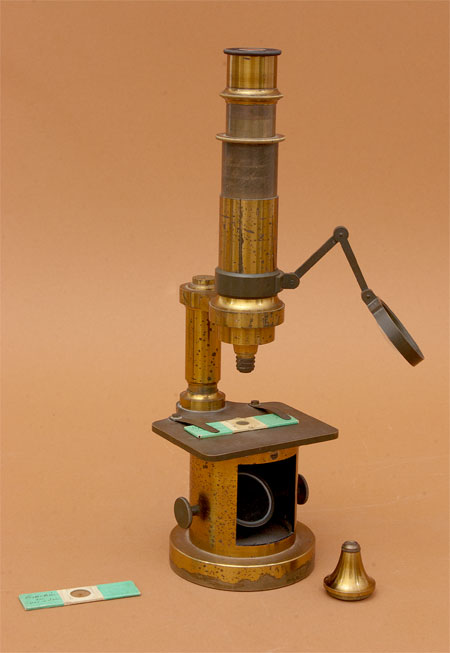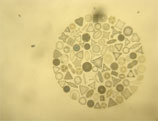 |
|||||
 |
 |
||||
 |
|||||
 |
 |
||||
Oberhaeuser Drum Microscope (No. 191) |
||||||||||
 |
Age: 1849/1850 Made by: Georges Oberhaeuser Made in: Paris |
|||||||||
 |
||||||||||
|
G. Oberhaeuser
Place Dauphine Paris |
||||||||||
 |
||||||||||
|
Imaging
|
||||||||||
|
This Drum Microscope (Oberhaeuser #1956) has a lead-filled base with a substage cutout to reveal the planoconcave illumination mirror. A spring-loaded focusing mechanism is contained within the support shaft and is actuated by a knurled knob beneith the shaft. The optics consist of three eyepieces, two nosepieces, and two objective lenses. The low magnification lens is a single plano-convex lens. The other nosepiece has an objective of three stacked lenses. There is a Bull's Eye lens (planoconvex) for illuminating opaque samples. The microscope body tube has no field lens, however it telescopes to allow for different focal length objective lenses and the three eyepieces. Specimens are held onto the stage with spring clips. This microscope comes with several, labeled glass slides and a mahogany storage case. The case also is stamped with the serial number "1956". This serial number dates the manufacture of the instrument precisely to 1849/50*. Imaging is good with a maximum magnification of approximately 125x. The microscope is 23cm tall. In 1830 Georges Oberhaeuser (1798–1868) formed an instrument firm in Paris with Trecourt and Bouquet. After c1835, Oberhaeuser worked alone making, among other instruments, drum microscopes. He established a partnership in 1857 with his nephew Edmund Hartnack (1826–1891). In 1860 Georges relinquished control of the firm to Edmund. Oberhaeuser's firm changed hands two times after that, and by 1896 it was purchased by Nachet of France. The full lineage of the Oberhaeuser company is as follows: Trécourt & Oberhaeuser (French) -> Oberhaeuser -> Oberhaeuser & Hartnack-> Hartnack -> Hartnack & Prazmowski (Paris and Potsdam) -> Prazmowski (Paris)-> Bézu, Hausser & Co. -> (Alfred & Albert) Nachet 1896.**The drum microscope represents an evolution from the "Pocket Microscope" of Benjamin Martin (1704-1782), with improvements in the focusing mechanism, substage mirror, and optics. This microscope is identical to microscope No. 28 in the collection of the Royal Microscopical Society. *Thanks to: |
||||||||||
Microscope featured 10/04; 05/13